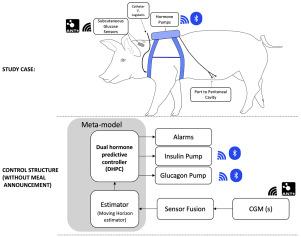全自动腹腔人工胰腺的双激素预测控制:猪的临床前评估
IF 3.9
2区 计算机科学
Q2 AUTOMATION & CONTROL SYSTEMS
引用次数: 0
摘要
全自动血糖水平调节(BGL)一直是治疗1型糖尿病(T1D)的最终目标。在这种情况下,全自动是指不需要任何患者交互的系统,例如膳食或运动通知或手动胰岛素调整。然而,对于人工胰腺(AP)系统来说,在没有这些输入的情况下实现BGL控制仍然是一个重大挑战,主要是由于膳食吸收的时间常数与皮下注射胰岛素的较慢吸收动力学之间的不利不匹配。在本文中,我们提出并测试了一种双激素腹腔(IP)人工胰腺系统-提供胰岛素和胰高血糖素-探索实现全自动血糖调节的挑战和可行性。为此,开发了一种预测控制方法,并在动物实验中进行了测试。实验在6头麻醉猪上进行12-24 h,在清醒(未麻醉)猪上进行5 d。该方法的时域(TIR, 3.9-10 mmol/L)为73.1-94.2%,超过了市售混合闭环系统的平均TIR。相比之下,美敦力MiniMed 670G的TIR为70%,Tandem t:slim X2的Control-IQ为72%,Omnipod 5的Horizon为70%,Diabeloop G7的TIR为74%。研究结果表明,使用双激素AP和IP注射实现BGL控制的完全自动化是可行的。本文还讨论了从头开始实施双激素IP人工胰腺系统的挑战和复杂性。这些挑战包括解决BGL的测量、估计、预测和手术考虑。本文章由计算机程序翻译,如有差异,请以英文原文为准。

Dual hormone predictive control for a fully automated intraperitoneal artificial pancreas: Preclinical evaluation in pigs
Fully automated regulation of blood glucose levels (BGL) has been the ultimate goal in the treatment of type 1 diabetes (T1D). In this context, full automation refers to a system that operates without requiring any patient interaction, such as meal or exercise announcements or manual insulin adjustments. However, achieving BGL control without such inputs remains a significant challenge for artificial pancreas (AP) systems, primarily due to the unfavorable mismatch between the time constants of meal absorption and the slower absorption kinetics of subcutaneously administered insulin. In this paper, we propose and test a dual-hormone intraperitoneal (IP) artificial pancreas system — delivering both insulin and glucagon — to explore the challenges and feasibility of achieving fully automated glucose regulation. To this, a predictive control approach was developed and tested in animal experiments. Experiments were conducted in six anesthetized pigs for 12–24 h and in an awake (unanaesthetized) pig for five days. The proposed method achieved a time-in-range (TIR, 3.9–10 mmol/L) of 73.1–94.2%, exceeding the average TIR reported for commercially available hybrid closed-loop systems. For comparison, the Medtronic MiniMed 670G reports a TIR of 70%, the Tandem t:slim X2 with Control-IQ achieves 72%, the Omnipod 5 with Horizon reports 70%, and the Diabeloop G7 achieves 74% TIR. The findings demonstrate that the full automation of BGL control using dual-hormone AP with IP injections is feasible. The paper also discusses the challenges and complexities associated with implementing the dual-hormone IP artificial pancreas system from the ground up. These challenges include addressing BGL measurement, estimation, prediction, and surgical considerations.
求助全文
通过发布文献求助,成功后即可免费获取论文全文。
去求助
来源期刊

Journal of Process Control
工程技术-工程:化工
CiteScore
7.00
自引率
11.90%
发文量
159
审稿时长
74 days
期刊介绍:
This international journal covers the application of control theory, operations research, computer science and engineering principles to the solution of process control problems. In addition to the traditional chemical processing and manufacturing applications, the scope of process control problems involves a wide range of applications that includes energy processes, nano-technology, systems biology, bio-medical engineering, pharmaceutical processing technology, energy storage and conversion, smart grid, and data analytics among others.
Papers on the theory in these areas will also be accepted provided the theoretical contribution is aimed at the application and the development of process control techniques.
Topics covered include:
• Control applications• Process monitoring• Plant-wide control• Process control systems• Control techniques and algorithms• Process modelling and simulation• Design methods
Advanced design methods exclude well established and widely studied traditional design techniques such as PID tuning and its many variants. Applications in fields such as control of automotive engines, machinery and robotics are not deemed suitable unless a clear motivation for the relevance to process control is provided.
 求助内容:
求助内容: 应助结果提醒方式:
应助结果提醒方式:


